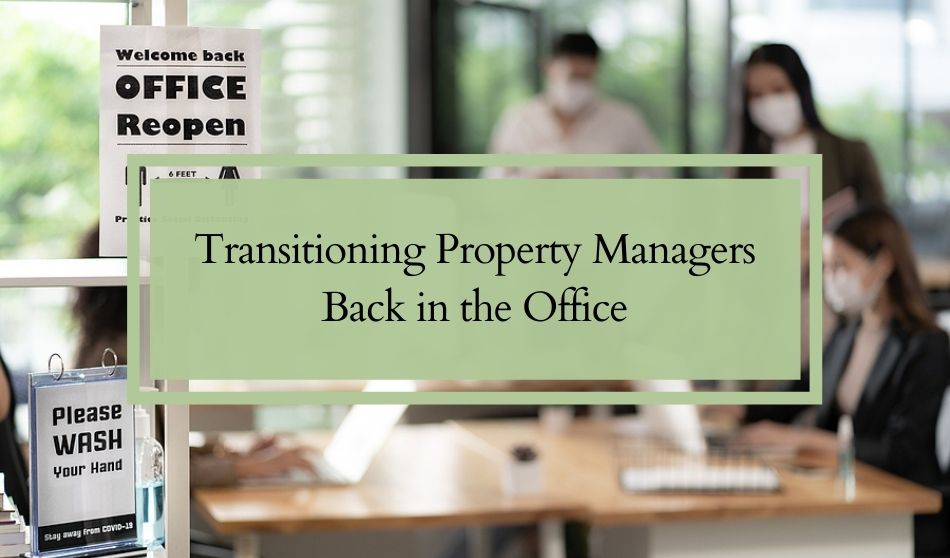
When working remotely has become the norm, transitioning property managers back in the office can feel a bit overwhelming in light of all fluctuations in regulations and recommendations.
For some of the country, it’s been business as usual throughout the pandemic where offices remained open to the public. In that, it’s not a hard task to continue with safety protocols. But for many property management and leasing offices, virtual offices have become commonplace so reopening the doors may take some preparation.
Bringing property managers and rental office staff back to work in the office doesn’t have to be a daunting process — a little planning can go a long way to alleviate that stress.
Transition Planning
Change seems to be the only constant when it comes to the recommendations revolving around the COVID-19 pandemic — from the newest eviction moratorium extension to mask recommendations and mask mandates — making planning that much more difficult and yet more important for designing contingency plans.
You’ve got some hard decisions that need to be made. For instance, will you:
— mandate, encourage, or stay neutral about vaccines.
— require masks and distancing beyond what is required by your state regulations.
— screen for symptoms or have your employees and visitors self-screen.
— have staggered work schedules or modified office hours?
— need to create distance between staff desks and guest seating?
Also to consider in your planning are the protocols if regulations and requirements relax or increase nationwide and/or regionally.
IMPORTANT: When preparing a return strategy for your employees, ensure you are in compliance with any regulations set out by the Center for Disease Control (CDC) and The Occupational Safety and Health Administration (OSHA) as well as any local or state guidelines. Be aware that each state also has an OSHA chapter and those and other state and local guidelines may differ from the national standards. You can find your state OSHA chapter and state plans here:
OSHA Offices and State Plans Map
In addition to OSHA requirements, states and local jurisdictions may also be setting specific regulations on what is and isn’t appropriate based on the rise and fall of cases in that area.
It’s important to note that your location will dictate how much of your planning can be determined by your business needs and which protocols are mandatory. But be careful setting your standards in stone because regulations are in flux around the country.
Be sure to check with the CDC as well as your state and county regulations, including OSHA requirements, regarding mask and distancing when planning your back to work protocols for your property managers and office staff.
Return Strategy
Once you have a plan in place, your return strategy should include scheduling, safety measures, and communicating changes with your employees, tenants, owner, and vendors. For example, you might want to prepare:
- Employees by setting responsibilities and expectations for cleaning, distance, schedules, and other protocols.
- Tenants and owners by providing answers to important questions like modified office hours or changes to payment or complaint policies, etc.
- Vendors by setting expectations for tenant interactions and other protocols.
In addition to imposing nationwide or location-specific eviction moratoriums, the CDC has resources for best practices and the most current recommendations for keeping your office staff, residents, and guests safe.
Resuming Business Toolkit (checklist, infographic)
CDC Workplace and Businesses Prevention Strategies
CDC Covid-19 Employer Information for Office Buildings
When it comes to scheduling, some larger offices are opting for a tiered approach, modified office hours, staggered shifts, staggered breaks, etc. Your back to office return strategy should accommodate what works best for your business needs.
Tips to Help Return to the Office
We’ve been here before. Just a year ago offices were opening back up for a short period of time before shutting down again. We don’t know if new mandates will be enacted putting office workers back at home. But in the meantime, staying ready to pivot whatever the current weather is about keeping educated and flexible. To help, here is a COVID related article from last year with some tips on health and safety in the workplace:
Property Management Tips for Returning to Work
Putting it all together for the transition back into the office the theme is still Safety First. Your employees, vendors, prospects, owners, and tenants are all counting on you to be a leader in this arena. Be sure to check out the links in this article to stay up-to-date to make transitioning property managers bank in the office a breeze.
Reminder: If you haven’t updated or created your safety binders and disaster preparedness plan, now’s a perfect time. Here’s are some tips to get you started: Disaster Preparedness for Your Rental Properties